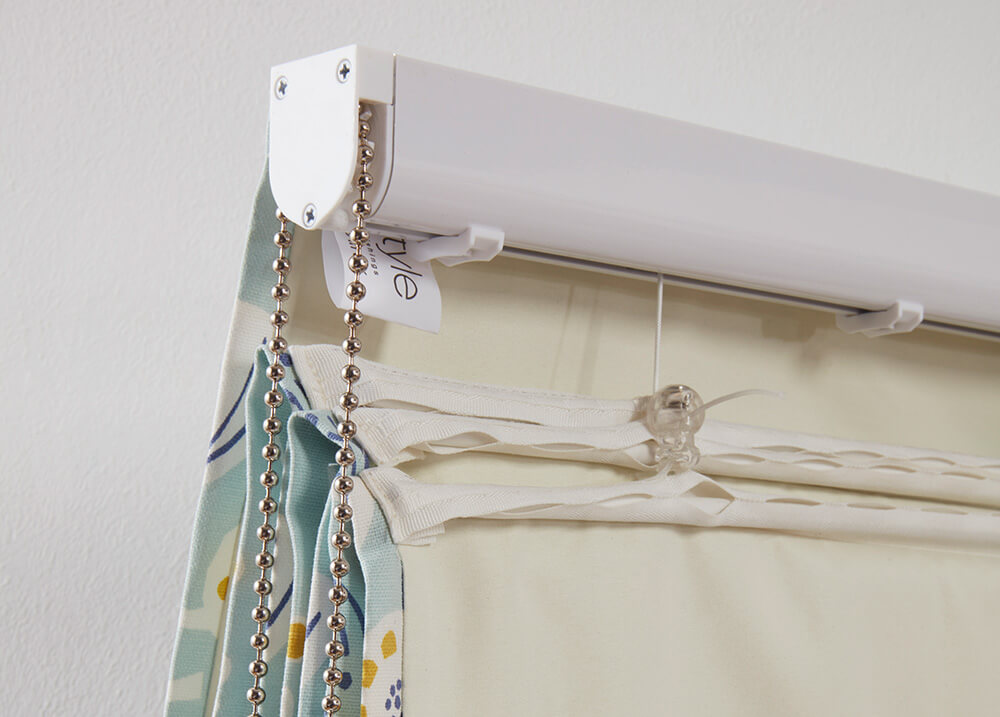Learn how to string or restring a roman blind using tried and true methods from our team of experts here at Unbeatable Blinds. In this guide we walk you through the process, from threading the cords to adjusting the blind for perfect alignment. Follow each step and you’ll have your blinds up and working good as new in no time!
How to String a Roman Blind: Step by Step
The steps below also cover how to restring a roman blind if you’re planning on replacing old cords.
Removing the Roman Blind
If you’re replacing the strings on an old roman blind, you should begin by detaching the fabric from the headrail. Most Roman blinds are secured using Velcro strips making it easy to detach them without damaging the fabric or headrail. Once removed, lay the blind flat on a clean surface to prevent any dirt or creases.
Removing the Old Strings
If re-stringing, locate the old cords on the back of the blind and carefully cut them away from the blind. Ensure all strings are fully removed, including any knots or tangles, to allow for a smooth re-threading. Once complete, your blind is ready for fresh cords.
Threading the Cords
Starting from the top of the blind, take your new cord and thread it through each eyelet, moving downward. Once at the bottom, secure the cord by threading it through the safety device. Now you’ll need to decide which side you want the pull cord will be on—this will affect the threading direction in the next step.
Fixing the Blind to the Batten
To attach the blind, align and press the Velcro strips on the top of the blind and the batten together. If possible, stand in front of the window, behind the blind, so you can easily reach the batten’s eyelets. This will make threading the cords easier.
Attaching the Cords to the Batten
Thread each cord through the corresponding eyelets on the batten. Depending on which side you’ve chosen for the pull cord, either work from left to right (for a left-sided pull cord) or right to left (for a right-sided pull cord). Once threaded, gather all the loose ends and thread them through your wooden acorn. Make sure you tie a loose knot to prevent the cords from slipping back through the eyelets and leave some excess cord for adjustments later.
Adjusting the Cord Length
Test the blind by raising and lowering it a few times to ensure it sits level. When the blind is fully lowered, determine where the wooden acorn should rest—typically it should sit a short distance from the last eyelet on the batten. Tie a knot just above the acorn to keep the cords together and trim off the excess cord. The knot should be hidden inside the acorn when it’s pulled down over it.
Making the Final Adjustments
If the blind is uneven after your adjustments, you can fine-tune it by pulling the cords through the safety devices at the bottom of the blind. Adjust the length of each cord until the blind hangs evenly.
Installing the Cleat
For safety, especially in homes with children, the child-safety device should be installed at least 1.5 meters above the floor. Secure it to the wall using two screws. Once secure in the wall, wrap the cord tightly around the cleat to prevent any loose ends from dangling.
Once the cords are threaded, adjusted, and the child-safety device is installed, your Roman blind is ready for use. Remember, this guide not only shows how to string a roman blind, but it’s also helpful for restringing and replacing old parts too! Follow it step-by-step and you’ll be able to keep your blinds in top condition for years to come.
FAQs
Can I Restring my Roman Blind?
Yes, if your roman blind is sitting unevenly or not working correctly it can be a good idea to replace the string cords. Follow our steps above on how to restring a roman blind to ensure everything goes smoothly. If you’ve purchased a made to measure roman blind from Unbeatable Blinds, you may find your blinds are still under warranty if purchased within the last year. If so, contact our customer support team and we may be able to replace your roman blind for free!
Where to Buy Roman Blind String
Generally, heavy duty, non-stretch polyester is used to string roman blinds. You should be able to find this easily online or at local textile or DIY shop.
 White
White Blue
Blue Grey
Grey Green
Green Black
Black Pink
Pink Natural
Natural Purple
Purple Cream
Cream Orange
Orange Brown
Brown Red
Red Silver
Silver Gold
Gold
 Your Samples
Your Samples
